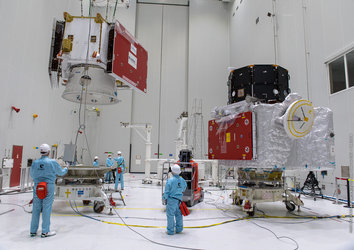Accept all cookies Accept only essential cookies See our Cookie Notice

About ESA
The European Space Agency (ESA) is Europe’s gateway to space. Its mission is to shape the development of Europe’s space capability and ensure that investment in space continues to deliver benefits to the citizens of Europe and the world.
Highlights
ESA - United space in Europe
This is ESA ESA facts Member States & Cooperating States Funding Director General Top management For Member State Delegations European vision European Space Policy ESA & EU Space Councils Responsibility & Sustainability Annual Report Calendar of meetings Corporate newsEstablishments & sites
ESA Headquarters ESA ESTEC ESA ESOC ESA ESRIN ESA EAC ESA ESAC Europe's Spaceport ESA ESEC ESA ECSAT Brussels Office Washington OfficeWorking with ESA
Business with ESA ESA Commercialisation Gateway Law at ESA Careers Cyber resilience at ESA IT at ESA Newsroom Partnerships Merchandising Licence Education Open Space Innovation Platform Integrity and Reporting Administrative Tribunal Health and SafetyMore about ESA
History ESA Historical Archives Exhibitions Publications Art & Culture ESA Merchandise Kids Diversity ESA Brand Centre ESA ChampionsLatest
Space in Member States
Find out more about space activities in our 23 Member States, and understand how ESA works together with their national agencies, institutions and organisations.
Science & Exploration
Exploring our Solar System and unlocking the secrets of the Universe
Go to topicAstronauts
Missions
Juice Euclid Webb Solar Orbiter BepiColombo Gaia ExoMars Cheops Exoplanet missions More missionsActivities
International Space Station Orion service module Gateway Concordia Caves & Pangaea BenefitsLatest
Space Safety
Protecting life and infrastructure on Earth and in orbit
Go to topicAsteroids
Asteroids and Planetary Defence Asteroid danger explained Flyeye telescope: asteroid detection Hera mission: asteroid deflection Near-Earth Object Coordination CentreSpace junk
About space debris Space debris by the numbers Space Environment Report In space refuelling, refurbishing and removingSafety from space
Clean Space ecodesign Zero Debris Technologies Space for Earth Supporting Sustainable DevelopmentApplications
Using space to benefit citizens and meet future challenges on Earth
Go to topicObserving the Earth
Observing the Earth Future EO Copernicus Meteorology Space for our climate Satellite missionsCommercialisation
ESA Commercialisation Gateway Open Space Innovation Platform Business Incubation ESA Space SolutionsLatest
Enabling & Support
Making space accessible and developing the technologies for the future
Go to topicBuilding missions
Space Engineering and Technology Test centre Laboratories Concurrent Design Facility Preparing for the future Shaping the Future Discovery and Preparation Advanced Concepts TeamSpace transportation
Space Transportation Ariane Vega Space Rider Future space transportation Boost! Europe's Spaceport Launches from Europe's Spaceport from 2012Latest

BepiColombo spacecraft stack
Thank you for liking
You have already liked this page, you can only like it once!
BepiColombo, a joint ESA and JAXA mission to Mercury, has completed its final tests in launch configuration, the last time it will be stacked like this before being reassembled at the launch site next year.
The image was taken on 6 July, during a dedicated press event where media were invited to see BepiColombo in ESA’s test centre. In the coming weeks, the three spacecraft elements will be separated for a final set of tests.
The Mercury Transfer Module is seen at the bottom of the stack, with one folded solar array visible to the right. When both solar arrays are deployed they span about 30 m. The module will use solar-electric propulsion as well as gravity assists at Earth, Venus and Mercury to carry two science orbiters to Mercury orbit.
ESA’s Mercury Planetary Orbiter is seen in the middle of the stack (with the folded solar array towards the left and antenna to the right). JAXA’s Mercury Magnetospheric Orbiter sits at the top of the 6 m-high stack. During the cruise to Mercury it will be protected by the Magnetospheric Orbiter Sunshield and Interface Structure (MOSIF), which in this image is sitting on the floor to the right.
After arriving at Mercury, the modules will separate, and from their respective orbits the science orbiters will make complementary measurements of Mercury’s interior, surface, exosphere and magnetosphere, following up on many of the open questions raised by NASA’s Messenger mission.
The final tests completed with BepiColombo in the launch configuration – also with the MOSIF in place – were vibration tests to simulate the shaking conditions at launch. In the coming weeks the assembly will be dismantled and the individual modules will undergo final checks following the vibration test, including solar array deployment tests. In addition, the transfer module will undergo a thermal vacuum test to simulate the extreme environmental conditions expected during the cruise.
The spacecraft is scheduled to leave Europe in March, with a launch from Kourou, French Guiana, anticipated in October 2018, and arrival at Mercury at the end of 2025.
See here for the latest status update, and our video gallery for examples of some of the recent tests.
-
CREDIT
ESA–C. Carreau -
LICENCE
CC BY-SA 3.0 IGO or ESA Standard Licence
(content can be used under either licence)

Completing the BepiColombo stack

BepiColombo stack

BepiColombo stack

BepiColombo stack – with sunshield















 Germany
Germany
 Austria
Austria
 Belgium
Belgium
 Denmark
Denmark
 Spain
Spain
 Estonia
Estonia
 Finland
Finland
 France
France
 Greece
Greece
 Hungary
Hungary
 Ireland
Ireland
 Italy
Italy
 Luxembourg
Luxembourg
 Norway
Norway
 The Netherlands
The Netherlands
 Poland
Poland
 Portugal
Portugal
 Czechia
Czechia
 Romania
Romania
 United Kingdom
United Kingdom
 Slovenia
Slovenia
 Sweden
Sweden
 Switzerland
Switzerland

























